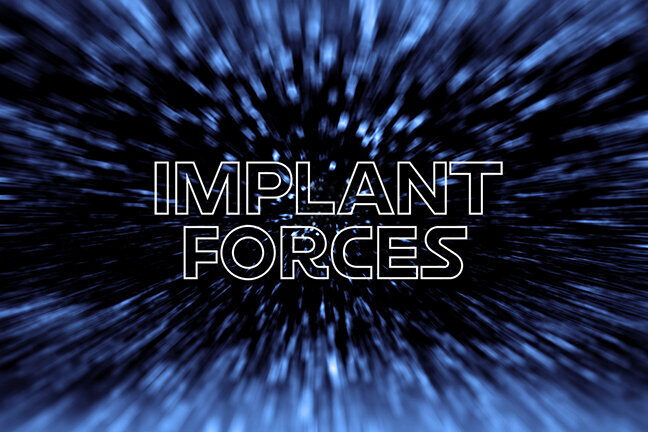Are you a Jedi, or Are you Causing a Disturbance in the Force?
Unless you’ve lived under a rock—and not one on the planet Tatooine—you know the cinematographic tales of the Jedi and their quest to preserve peace in the universe. The success of their mission, like the success of implant treatments, hinges on balance in the Force. A Jedi harnesses the Force for knowledge and defense, but never for attack. Unfortunately, when factors affecting implant success aren’t properly considered, the Dark Side could basically destroy the overall treatment. Put another way, the Dark Side is the potential for Force imbalances to cause peri-implant bone loss and implant prosthesis failure.
So what is the Force we’re talking about? According to Merriam-Webster, force can be defined as (1) strength or energy exerted or brought to bear that causes motion or change; (2) an agent or influence that, if applied to something, leads to its acceleration or deformation; or (3) any natural influence that exists that determines the structure of the universe. There are nine forces that influence implant success or failure and that dentists must consider during treatment planning. These include apical, lingual, distal, mesio-distal, occlusal, facial, facio-lingual, mesial, and vertical axis forces. If there is a disturbance in any of these, the dental implants could be prone to occlusal overload.
It is also critical that the Jedi understand forces even during sleep. As a matter fact, the dark side uses even more deceptive and tricky means to cause implant failure. In REM sleep, our brain is being recharged. Long and short-term memories are being consolidated and organized. Just like a cell phone needs to be recharged, so do our brains. However, in REM sleep our bodies are paralyzed and all muscles are atonic. Then, gravity like that on Earth, or even on a Death Star becomes our biggest enemy. If we are sleeping supine on our back, then the emperor uses spells on our tongues to fall back and block the airway. Next, our oxygen saturation levels decline to life threatening levels and our bodies shift from being In parasympathetic to sympathetic (fight or flight). Then, the movement disorder known as sleep bruxism can be executed by the emperor’s hands. During this horrible process, the mandible can be forced to move in so many different dimensions, creating torque, class 1-4 interferences and premature contacts, similar to “force lightning“ that the dark side emperor uses. Thus, it is critical to screen for airway issues and breathing disorders in all patients who come in your door.
The good news is that you can be a Jedi and apply your knowledge of these forces, to defend your treatments against the consequences of the Dark Side. Implant force disturbances can occur due to problems with large cantilevers, patients with 3 para-functional habits/ bruxism, occlusal interferences, and/or poor-quality bone. Limited contacts result in poor force distribution, and steep cusp inclines and increased cusp height equate to bone loss. Just like a Jedi must exercise control to better harness the power of the Force, so too must dentists take into consideration and control variables like these that affect implant occlusion in order to ensure long-term treatment success.
This means managing Force in the best ways possible; in other words, establishing protected implant occlusion, and much of that depends on implant placement and prosthetic design. Among the recommendations for achieving the best protected implant occlusion are ensuring straight and centered axial occlusal force load; a narrow occlusal table; and reduced cusp inclination, which concentrates forces over the central fossa. The Jedi implant dentist keeps in mind that ideal occlusal centric contacts are loaded as much as possible on the central fossa, avoiding the marginal ridge.
And remember, too, that the balance you’re seeking is all about how everything in the implant-restoration complex works together—like ideal occlusal timing and an increased implant surface area, which decreases stress (also known as the Dark Side of the Force). Depending on the case, you may need to create long contact areas by using wider implants and/or splinting implants, which also helps to decrease marginal bone loss, abutment screw loosening, and porcelain and component fracture. Or, you might need to reduce the length of cantilevers or the crown-implant ratio, or decrease 4 anterior guidance, especially since a 10-degree increase causes a 30% increase in loading of the prosthesis and/or implant. If you don’t prevent disturbances in these forces, the stress will impact the abutment and implant neck, causing screw loosening, fatigue fracture, and destruction.
The bottom line: Balance in the Force is never by chance. When everything works together, that’s when peace and balance in the universe of your implant treatment occurs. And that’s why it’s essential to communicate with your MicroDental Laboratory technician throughout the implant treatment planning process. Through collaboration, components of the implant-restoration complex can be properly designed to ensure protected occlusion, an ideal crown-implant ratio, and that lateral and sheer forces are avoided.
About the author:
Dr. Jerry Hu
Founder, Smiles of Alaska
Jerry Hu, DDS, is triple board-certified in dental sleep medicine and holds masterships, fellowships, and accreditations in implant and cosmetic dentistry. He also has published numerous clinical studies in peer-reviewed, highly respected journals such as AACD's Journal of Cosmetic Dentistry and AADSM's Journal of Dental Sleep Medicine. Dr. Hu also teaches for Modern Dental Group both nationally and internationally and for Sleep Group Solutions, VIVOS growth guidance appliance group, and Prosomnus Sleep Technologies. He also has won numerous awards in cosmetic and implant dentistry from Macstudio Model Search by MicroDental, and the IAPA Aesthetic Eye competition. He is currently working on a patent for dental sleep medicine and looking to help the US military out in dental sleep medicine.


